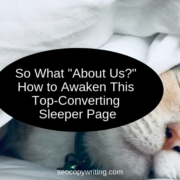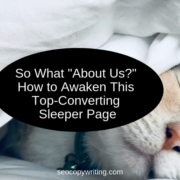What Maslow Can Teach You About Copywriting
Greetings! You’re in for an intriguing SEO copywriting video today, as we enter the realm of customer psychology – specifically, tapping your customers’ psyche to create truly engaging, powerful content!
Based on psychologist Abraham Maslow’s “Hierarchy of Needs,” Heather walks us through the emotional (and motivational) levels of the psyche and illustrates how to tie your copy into each one with specific website examples.
So tune in to learn how to make your copy resonate with your customers on their deepest psychological levels, from their most basic physiological needs to their lofty esteem needs and aspirations.
As you’ve most likely gathered from Heather’s webinars and/or some of her blog posts, she discusses the psychology of copywriting a lot. The reason?
- People make their buy decisions based on psychology: they ultimately buy based on their emotion.
Granted, they do their research, talk to their friends, and do their due diligence, but at the end of the day, their buy decision is an emotional decision.
That’s why…
Maslow’s Hierarchy of Needs
…is so important to copywriting.
- If you can tie your ad or website copy to something that is part of your customers’ psychological hierarchy of needs, you can write more compelling and powerful copy – content that resonates with what your customers’ are thinking about, are worried about, and/or want to achieve.
This first graphic is a little reminder of what Maslow’s hierarchy of needs are, which you may recall from high school or college: at the base of the pyramid are the basic physiological needs for survival, then progressing (evolving) upwards through safety needs, social needs, esteem needs, and finally, self-actualization.
This psychological “needs” pyramid represents what Maslow thought we all experience, as we move beyond our instinctual physiological needs of food, water, etc., to the need to become self-actualized human beings.
So what follows is how Maslow’s hierarchy of needs can inform and improve your copywriting, illustrated with specific examples from the Web.
Physiological Needs
The Help-4-Homes (Save Your Home Today!) website is a great example of content that is targeted to basic, physical needs: it is geared towards people who are almost in foreclosure and face losing their house.
This is very freaky situation for folks to deal with – they’re confused, they’re scared, and they’re looking for options. The web copy reflects the readers’ feelings with a checklist of concerns: has your mortgage rate been reset (and you can’t afford it)? Have you suffered a financial hardship?
Then at the end of the copy is a really powerful testimonial from a client who affirms that she was going through this problem and contacted the company, and the company was able to help her.
- The copy ties into those elemental physiological needs and hits those high points with a checklist of concerns, followed by reassurance via a strong testimonial.
If you’re in an industry where physiological needs are the motivating factor, you can look to this example as a template for writing copy that is far more detailed and compelling than just “We can help you save your house” or “We can help you beat foreclosure.”
Safety Needs
An example of a website that addresses the psyche’s need for safety is ADT: they “specialize in home security.”
If you’re in the mindset where you want to buy a home security system, ADT’s benefit statements are most reassuring: it is the gold standard in home security; they offer a personal emergency response system; there is video surveillance plus intrusion detection.
- These benefit statements are crucial because they help the reader feel safe. They let the reader know that he’s at the right place, he’s working with a company that can help him, and that understands his needs.
So if you’re working with a company that deals with safety, ADT’s web content is a fantastic example of a different way to approach the copy. And again, it is far more powerful than just “We’ll help keep you safe”, as it details specific benefits to help the reader feel at ease.
Social Needs
Here is another core psychological need that we all have, and one that can be tapped in creating copy (and images).
In this example of Pottery Barn’s website, you’ll notice that it really doesn’t say all that much. The company’s writers could do a lot more to flesh it out and make it seem more social, certainly.
But what grabs you is the picture: this cozy table setting with four glasses of wine. It tells a story. Somebody has been there, hanging out with friends, and enjoying the view of the water (presumably Chesapeake Bay). It conveys a very comfortable, social type of environment.
- So not only can you use words to tie into one of Maslow’s hierarchy of needs, but you can also use images. Remember that you’ll want to make sure that your images are helping to reinforce what you’re saying in the copy.
Esteem Needs
Finally, we’re going to end our discussion with the psyche’s esteem needs: these are the people that want to impress, and that want the best of the best.
The website example here is Dream Homes Magazine.com, where you can browse these spectacular homes and luxury rentals located all over the United States and Mexico.
It is definitely about “living the dream.”
So if you’re working with luxury goods and things that are more exclusive, you could tie your copy into Maslow’s “esteem needs” in his hierarchy: that will help people connect better, because that is precisely what they’re looking for.
- Folks with esteem-based psychological needs are seeking that exclusivity, that rarity and privilege of an experience that not everyone can have – one that they know they’ll be able to talk about and remember all their lives.
A Concluding Thought
If you’re a copywriter and want to learn how to write better, especially for conversions, then you’ll want to do a lot of reading around psychology. The more you understand about what makes people “tick” and the underlying psychology of their motivation, the better your content will be!
photo thanks to BetterWorks, Inc.










When writing content it’s important to think about what your target audience needs and wants. Content shouldn’t only be about pitching your product. What will get you noticed and make you stand out is if you actually help potential customers. Over time, as you become a trusted source of information, you will get sales and leads through your efforts.